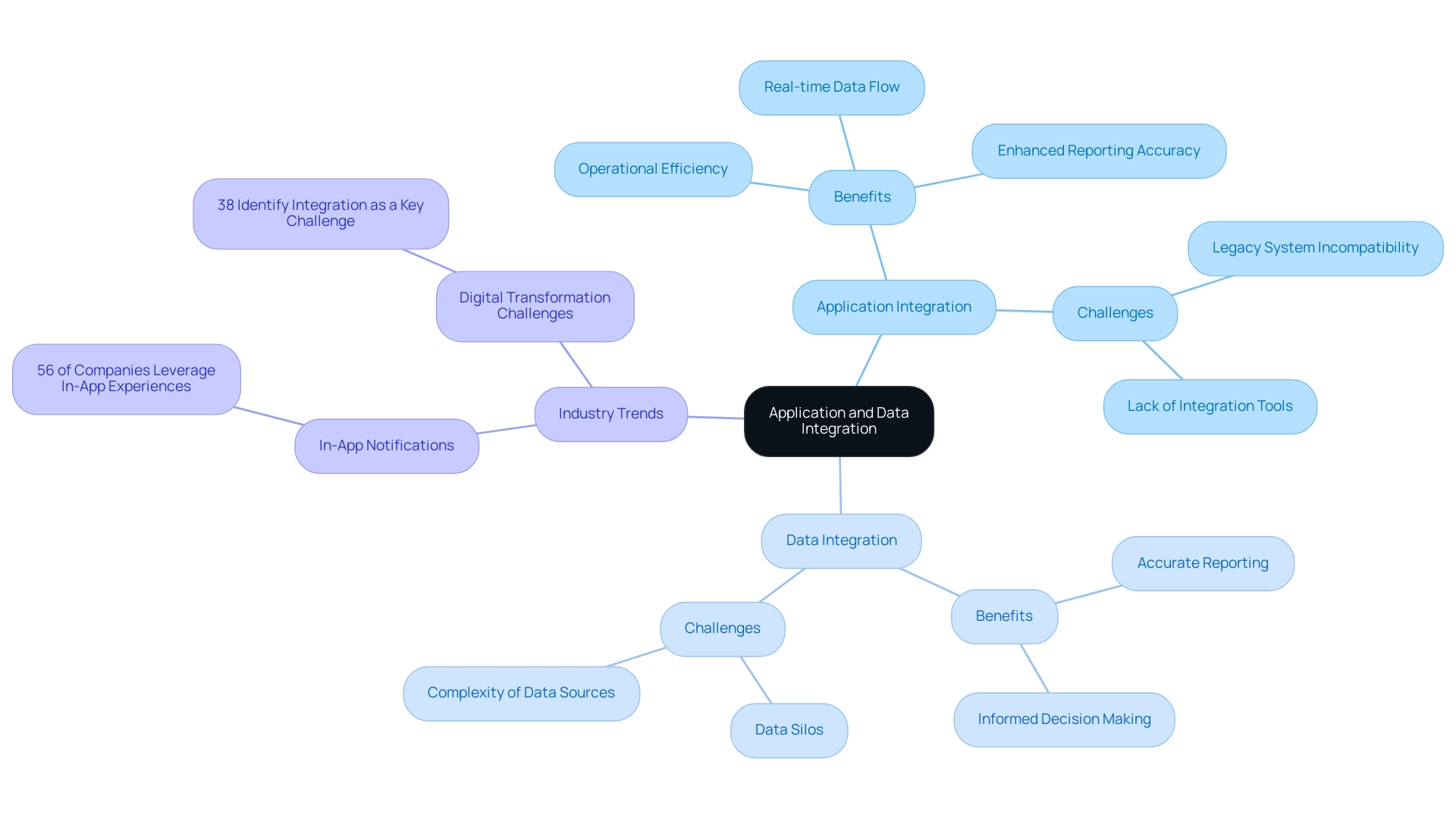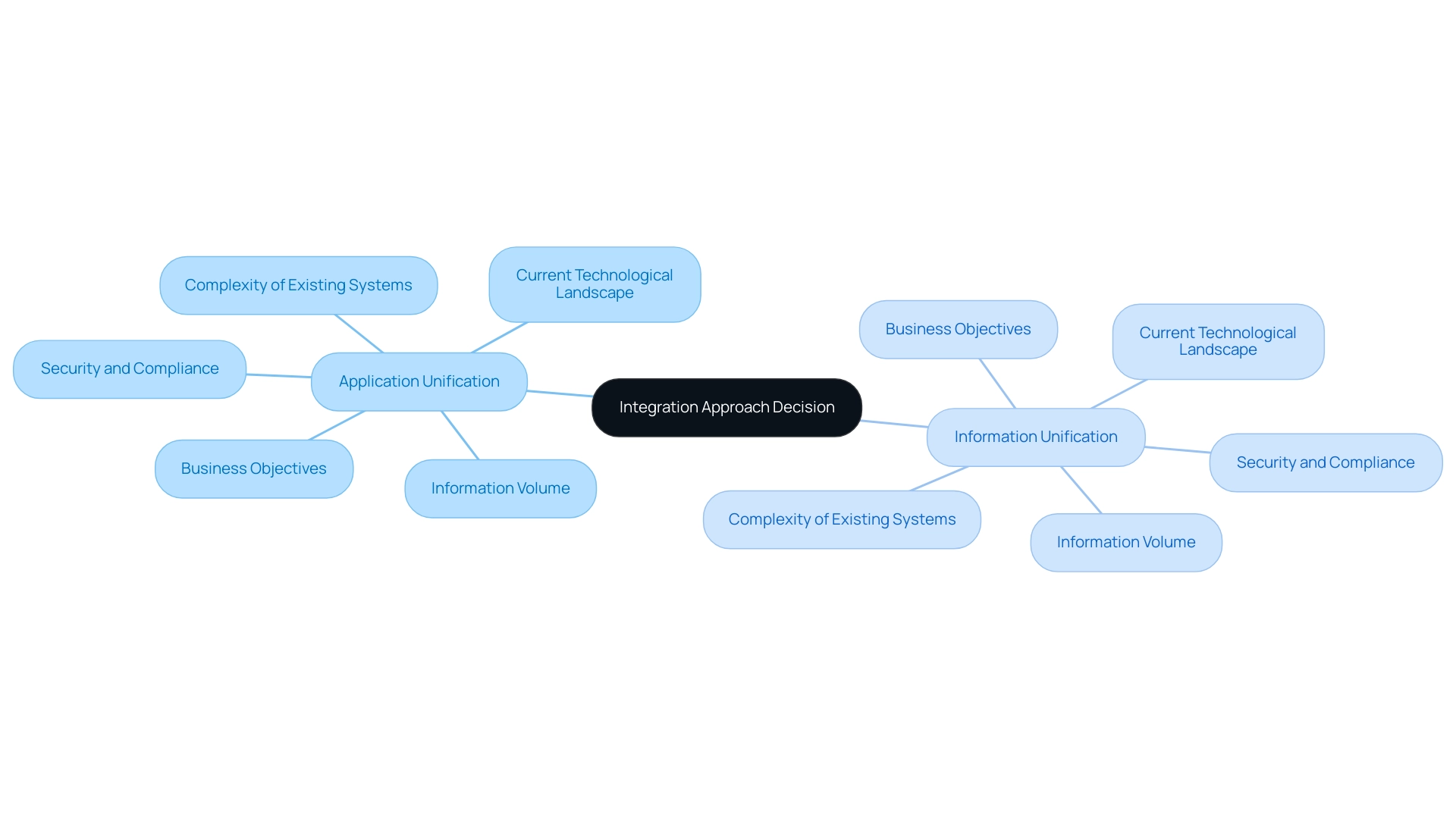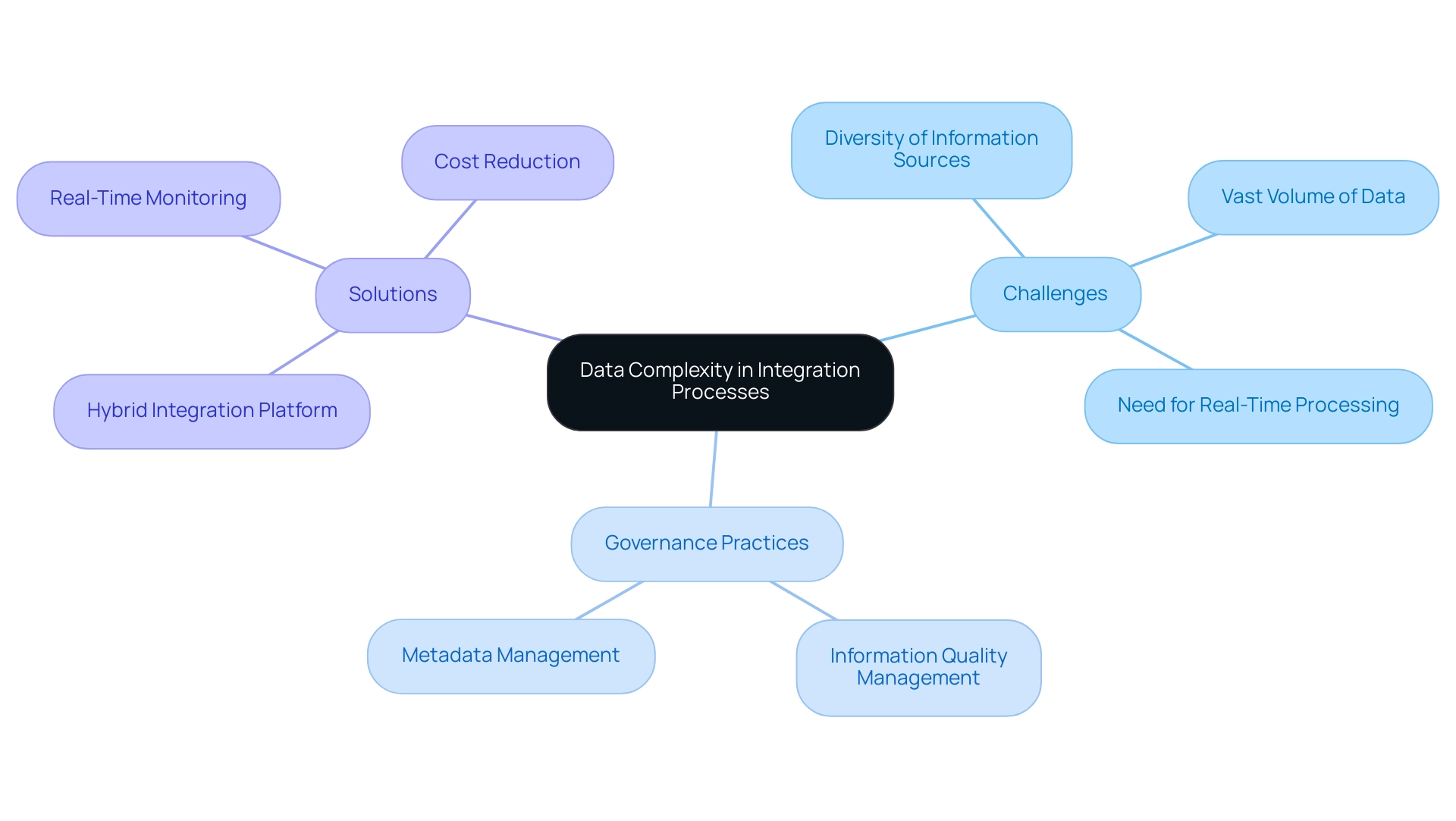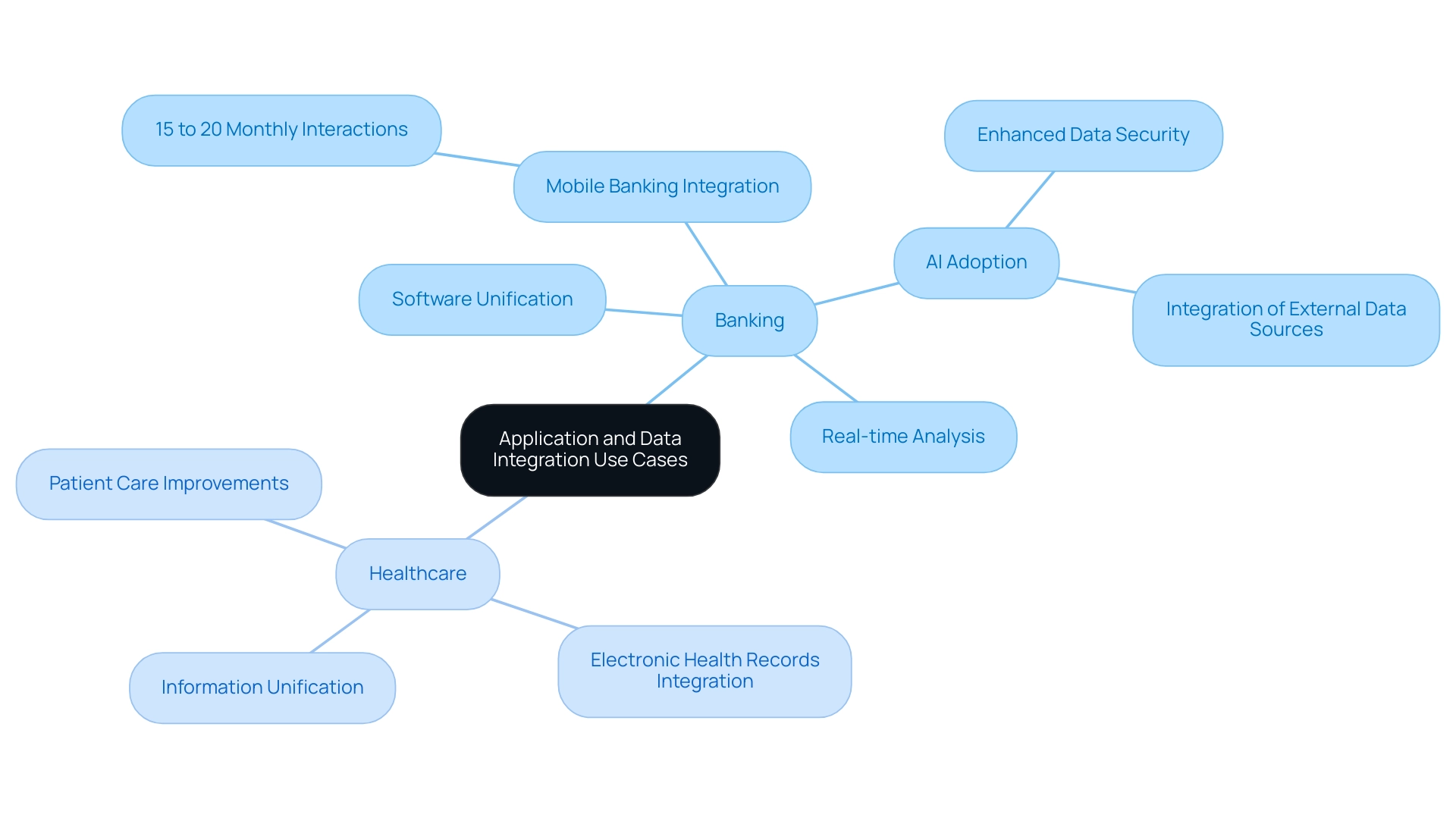Overview
Application integration enhances operational efficiency and facilitates real-time data sharing among systems. In contrast, data integration emphasizes the consolidation of information, which is crucial for accurate reporting and analytics. This article illustrates how application integration dismantles data silos, enriching customer experiences. Furthermore, data integration ensures information consistency and compliance. By highlighting the distinct benefits and challenges inherent in each approach, we can better understand the importance of choosing the right integration strategy for your organization.
Introduction
In an increasingly interconnected world, the ability to seamlessly integrate applications and data has become a critical factor for organizational success. As companies strive to enhance operational efficiency and improve customer experiences, understanding the nuances between application integration and data integration is essential.
- Application integration focuses on connecting disparate software systems for real-time collaboration, while
- data integration emphasizes consolidating information from various sources to enable informed decision-making.
This article explores the benefits, challenges, and strategic considerations of both integration approaches, highlighting the transformative potential of platforms like Avato in navigating the complexities of modern IT environments.
By examining real-world use cases and expert insights, organizations can position themselves to leverage integration as a catalyst for growth and innovation.
How can your organization harness these integration strategies to overcome challenges and drive success?
Understanding Application Integration and Data Integration
Linking different software systems is a crucial method for connecting various programs, enabling seamless cooperation and efficient information exchange. This integration facilitates real-time data flow and automates processes, significantly enhancing operational efficiency. For instance, organizations that implement effective application unification strategies can drastically reduce the time spent on manual data entry and improve response times to customer inquiries, ultimately leading to superior service delivery.
The dedicated hybrid connectivity platform empowers companies to future-proof their operations by simplifying complex connections and maximizing the value of legacy systems. By unlocking isolated assets, Avato enables organizations to generate substantial business value and enhance customer experiences, particularly in regulated industries such as banking and healthcare. Moreover, the platform provides real-time monitoring and alerts on system performance, significantly reducing costs associated with system integration.
Conversely, information consolidation focuses on merging data from various sources into a unified perspective, which is vital for accurate reporting and analytics. By ensuring that information is harmonized and readily accessible, businesses can make informed decisions based on comprehensive insights. A recent study revealed that 38% of participants identified the unification of isolated systems and data as their primary obstacle in achieving digital transformation, underscoring the critical need for robust unification solutions like those offered by Avato.
The benefits of system unification extend beyond operational efficiency; they also enhance reporting accuracy. For example, companies utilizing integrated systems report a significant improvement in their ability to generate timely and precise reports, which is essential for strategic planning and compliance. As Jon Gitlin, Senior Content Marketing Manager, observed, “It was the same process, go talk to their team, figure out their API.”
This process was time-consuming, highlighting the challenges of integrating processes and the necessity for effective strategies.
Current trends in software unification indicate a growing reliance on in-app experiences to foster new connections. Notably, 56% of companies leverage in-app notifications as an effective means to engage users and promote the adoption of integrated solutions. This trend reflects a broader movement towards user-centric integration strategies that prioritize simplicity and accessibility, further emphasizing the platform’s significance in meeting these needs.
Expert opinions further highlight the importance of software unification for operational efficiency. As organizations navigate the complexities of modern IT environments, the capability to integrate legacy systems with new technologies becomes essential. Ineffective system cohesion often arises from the incompatibility of legacy platforms and a lack of unifying tools, challenges that Avato effectively addresses.
This integration not only mitigates risks associated with digital transformation but also positions businesses to adapt swiftly to evolving market demands.
In summary, both application integration and data integration are critical for enhancing business processes. By addressing the challenges posed by legacy systems and employing modern connectivity tools, organizations can unlock significant operational efficiencies and maintain a competitive edge in their respective industries. Avato’s commitment to architecting the technological foundation necessary to enable rich, connected customer experiences lies at the core of its mission.

Key Differences Between Application Integration and Data Integration
The essential difference between program unification and information unification lies in their distinct focuses and functionalities. System unification emphasizes the interoperability of software, facilitating real-time interaction and data exchange among them. This is typically achieved through APIs and middleware solutions, which enable seamless interactions between disparate systems.
For instance, organizations can leverage API gateways to connect various applications, thereby enhancing operational efficiency and responsiveness. Avato’s dedicated hybrid unification platform exemplifies this approach, empowering businesses, including banking IT managers, to simplify complex connection challenges and unlock isolated assets for enhanced business value creation.
Conversely, information amalgamation concentrates on the collection of details from diverse origins, employing techniques such as ETL (Extract, Transform, Load) processes. This method ensures that information is not only accurate but also readily accessible for analysis, thus supporting informed decision-making. Data unification typically occurs in batches, focusing on creating new datasets that reveal business insights and enhance usability and analytics capabilities.
While software unification is characterized by its dynamic and process-oriented nature, data unification tends to be more static and data-centric. Current trends indicate that 25% of executives report their CRM systems lack sufficient connections, underscoring the critical need for effective system unification strategies. Moreover, statistics reveal that 60% of Shopify app installations stem from customers actively exploring the marketplace, highlighting the importance of robust software connectivity in enhancing user engagement and satisfaction.
To illustrate these differences, consider the case of SamTrans, the San Mateo County public transportation agency, which encountered challenges due to IT teams spanning various agencies and departments. By utilizing Avato’s unification platform, they successfully dismantled barriers between these departments and consolidated dispersed information onto a single dashboard. Consequently, they significantly simplified decision-making processes, demonstrating how system unification can enhance organizational efficiency.
SamTrans noted, “They utilized the platform to dismantle the barriers between the various IT departments and successfully integrated the dispersed information onto a single dashboard for streamlined decision-making.”
In summary, while application integration and data integration serve distinct purposes, both are essential for modern enterprises aiming to optimize operations and leverage data effectively. Understanding these differences is crucial for IT managers in the banking sector as they navigate the complexities of integrating legacy systems with contemporary technologies. The hybrid platform not only addresses these challenges but also safeguards operations for the future, ensuring that companies can adapt to evolving technological landscapes.
Furthermore, Avato is committed to mobilizing stakeholders and leveraging the right technology to illustrate current and ideal states, as highlighted in our FAQs, reinforcing our dedication to providing comprehensive solutions.

Factors to Consider When Choosing an Integration Approach
Choosing between software and information unification is a critical decision for organizations, influenced by various factors such as the complexity of existing systems, information volume, and specific business objectives. For example, organizations with multiple applications requiring real-time information exchange often find application unification to be more beneficial. This approach facilitates seamless communication between systems, enhancing operational efficiency and responsiveness.
On the other hand, companies that prioritize information analysis and reporting may lean towards information unification. This strategy guarantees information consistency and accuracy, essential for informed decision-making and strategic planning. Indeed, a significant percentage of organizations report that information quality issues stem from disjointed systems, highlighting the need for a cohesive assimilation strategy.
The TCGA Data Portal, which encompasses all TCGA data related to clinical details of cancer tumors and human subjects, exemplifies the vital role of effective information synthesis in managing intricate datasets.
Security and compliance are paramount considerations, especially in regulated industries like banking and healthcare. Organizations must navigate stringent regulations governing how information is managed and shared. Thus, the chosen method should align with these requirements to mitigate risks associated with information breaches and non-compliance.
The hybrid connectivity platform is engineered for secure transactions, positioning it as a reliable solution for banks, healthcare, and government entities.
Recent statistics reveal that over 70% of enterprises face challenges related to the complexity of their current systems, which can hinder connectivity efforts. This complexity often necessitates a tailored approach, where the decision between application and information integration is dictated by the organization’s specific needs. The company accelerates the unification of isolated systems and fragmented data, establishing the connected foundation enterprises require to simplify, standardize, and modernize.
Expert advice suggests that organizations conduct a comprehensive assessment of their unification needs, considering both current and future requirements. For instance, a case study featuring Avato’s integrated platform illustrates how companies in the banking sector have effectively navigated these challenges. Clients, such as Gustavo Estrada from BC Provincial Health Services Authority, have praised the company for its ability to simplify complex projects and deliver results within desired timelines and budget constraints, thereby enhancing operational capabilities.
Tony Leblanc from the Provincial Health Services Authority also commended Avato’s team for their exceptional professionalism and expertise, further bolstering the company’s credibility.
Ultimately, the decision between application integration and data integration should be guided by a thorough understanding of the organization’s objectives, the current technological landscape, and the imperative for security and compliance. By carefully evaluating these factors, organizations can select a unification strategy that not only addresses their immediate needs but also positions them for future success. The company distinguishes itself from competitors by offering speed, security, and simplicity in integration, making it an attractive choice for organizations seeking to enhance their integration strategies.
Continuous monitoring and optimization capabilities, including robust analytics features, further ensure that Avato’s solutions remain effective and aligned with evolving business needs.

Navigating Data Complexity in Integration Processes
Data complexity presents a multifaceted challenge for organizations, especially in sectors like banking and healthcare. This complexity stems from various factors:
- The diversity of information sources
- The vast volume of data
- The critical need for real-time processing
In regulated industries, strict adherence to regulations complicates unification efforts, making effective information governance practices essential.
To tackle these challenges, organizations must prioritize information quality management and metadata management as foundational elements of their unification strategy. Implementing robust data unification tools, such as a Hybrid Integration Platform, is crucial for handling diverse data formats and maintaining data integrity throughout the process. This platform not only simplifies complex connections but also maximizes the value of legacy systems, significantly reducing costs associated with connection challenges.
Furthermore, the platform provides real-time monitoring and alerts on system performance, enabling organizations to proactively address issues as they arise. According to Cleo’s 2022 report, 85% of supply chain companies believe they are losing money due to inadequate business software system connections, with 24% stating they lose over $500K per year. This statistic underscores the financial repercussions of unification challenges and highlights how Avato’s solutions can mitigate these losses, ultimately enhancing operational efficiency.
Moreover, as the number of IoT connections is projected to reach 20.3 billion by 2025, the urgency for effective governance intensifies. Organizations that implement best practices in information management not only improve their assimilation success rates but also position themselves to adapt to evolving market demands. For instance, in the banking sector, comprehensive data governance frameworks have proven effective in managing data complexity, ensuring compliance, and enhancing decision-making capabilities.
Additionally, over 40% of firms consider the distinction between application integration and data integration a critical barrier to effective digital transformation, further emphasizing the need for strategic governance practices.
Gustavo Estrada, a client, remarked, “The company has simplified complex projects and delivered results within desired timelines and budget limitations.” This testimonial illustrates the tangible impact of effective solutions, showcasing the company’s capability to manage intricate connections and deliver timely outcomes. It highlights the platform’s strengths in transforming financial institutions by facilitating quicker product delivery and improving customer satisfaction.
In summary, addressing complexity through strategic governance practices, supported by Avato’s Hybrid Integration Platform, is vital for organizations striving to streamline their unification methods—particularly in distinguishing between application integration and data integration—to achieve their digital transformation objectives.

The Role of Automation in Application and Data Integration
Automation stands as a cornerstone in both usage and information merging, significantly reducing manual involvement and accelerating merging processes. In the realm of application unification, the comparison between application integration and data integration through automation facilitates real-time information exchange between applications, which not only expedites business processes but also enhances operational efficiency. For instance, organizations that have embraced automation report a staggering 93% reduction in invoice processing times, underscoring the tangible benefits of streamlined workflows.
The name, derived from the Hungarian word for ‘of dedication,’ embodies a commitment to architecting the technological foundation necessary for powering rich, connected customer experiences. Its dedicated hybrid connectivity platform plays a pivotal role in this landscape, empowering businesses to future-proof their operations through seamless information and system unification. By unlocking isolated assets, Avato enhances operational visibility and issue resolution, enabling organizations to concentrate on strategic initiatives rather than routine tasks.
The platform is meticulously architected for secure transactions, making it a trusted choice for sectors such as banking, healthcare, and government.
In information unification, automation significantly enhances ETL (Extract, Transform, Load) procedures. By automating these tasks, businesses ensure that information is consistently updated and readily available for analysis, thereby improving decision-making capabilities. The impact of automation on information assimilation processes is profound, as it minimizes errors and boosts overall efficiency.
Avato’s support for 12 levels of interface maturity allows organizations to balance the speed of implementation with the sophistication necessary to future-proof their technology stack.
However, the journey toward automation is not without challenges. Many organizations face hurdles such as initial implementation costs and resistance to change among employees. A considerable portion of the workforce harbors concerns about job security due to automation, highlighting the importance of addressing these anxieties to facilitate a successful transition.
Case studies reveal that organizations that proactively manage these challenges can reap substantial rewards, including improved employee and customer satisfaction, reduced operational costs, and enhanced decision-making.
As we advance into 2025, the role of automation in software unification continues to evolve, with sophisticated tools emerging to further refine application integration versus data integration processes. For example, CashCo Financial’s partnership with Feathery to unify their loan application processes resulted in an impressive 26% increase in approved loans, illustrating the effectiveness of automation in driving business outcomes. Gustavo Estrada from BC Provincial Health Services Authority remarked, “Avato has simplified complex projects and delivered results within desired time frames and budget constraints,” further emphasizing the value of automation in achieving system goals.
Overall, the ROI of automation encompasses enhanced employee and customer satisfaction, decreased costs, and improved decision-making, establishing it as a critical element of successful implementation strategies.
Long-Term Outcomes of Application vs Data Integration
The long-term results of implementation and data unification are pivotal in shaping an organization’s agility and competitive stance. Avato, with its innovative hybrid unification platform and unwavering commitment to building technology foundations for connected customer experiences, significantly enhances operational efficiency and accelerates response times to market fluctuations. This empowers organizations to innovate swiftly. A study by Cleo reveals that 25% of supply chain companies could incur losses exceeding $500K annually due to inadequate connectivity, highlighting the financial repercussions of insufficient application integration.
Moreover, information unification markedly improves decision-making by providing enhanced visibility and accuracy of information, which is essential for strategic planning. Organizations that effectively leverage data connectivity report a notable increase in their decision-making capabilities, with statistics showing that integrated data systems can yield a 20% enhancement in operational performance. Furthermore, the cloud-based EAI sector, valued at $3.1 billion in 2022, is projected to reach $10.03 billion by 2030, underscoring the growing importance and relevance of unification strategies in the banking industry.
As organizations pursue their long-term goals, selecting the right unification strategy becomes crucial. The appropriate approach not only fosters innovation but also secures a sustainable competitive advantage in an increasingly intricate landscape. In the banking sector, where regulatory compliance and data security are critical, the strategic benefits of robust data unification are particularly evident, enabling institutions to adeptly respond to evolving market demands and regulatory requirements. The company’s expertise in hybrid connectivity simplifies complex projects and delivers results within desired time frames and budget constraints, further affirming the effectiveness of connectivity solutions.
Additionally, with IBM generating over $750 million in EAI revenues in 2021, the financial viability and market demand for effective unification solutions are evident, bolstering the case for strong strategies. By harnessing generative AI, Avato empowers financial institutions to enhance customer experiences and operational efficiency, marking a transformational impact that encompasses cost reduction, expedited product delivery, and improved customer satisfaction.
Real-World Use Cases: Application and Data Integration in Action
In the banking industry, software unification is pivotal in linking diverse customer-facing systems, facilitating seamless transactions and real-time updates. For instance, the integration of mobile banking applications with backend systems has proven essential, particularly during the pandemic, when these apps accounted for approximately 15% to 20% of monthly interactions. This integration not only allows customers to access their accounts and execute transactions instantly but also significantly enhances user experience and operational efficiency by streamlining processes and minimizing wait times.
As financial institutions brace for the era of open banking, strategic unification methods become increasingly vital. By leveraging existing legacy systems instead of discarding them, banks can create a robust foundation for modernization. Avato’s hybrid unification platform exemplifies this strategy, enabling banks to build upon their current assets while ensuring compliance with stringent security protocols essential for open banking.
This platform provides functionalities such as real-time information synchronization, robust API management, and enhanced security measures, which mitigate risks associated with complex connections and accelerate the transition to a more interconnected financial ecosystem.
Conversely, information unification is crucial for healthcare organizations that must amalgamate patient records from various sources to ensure accurate and timely care. A notable example is a healthcare provider utilizing information unification to integrate electronic health records (EHR) from disparate systems. This approach not only delivers a comprehensive view of a patient’s medical history but also bolsters decision-making and improves patient outcomes.
By 2025, healthcare organizations are increasingly adopting advanced data unification strategies, driven by the necessity for real-time analytics and enhanced data security, both critical for effective patient management.
Real-world statistics underscore the significance of these unification strategies. High-performing banks have achieved sustained success through deliberate strategic decisions regarding their application unification, resulting in revenue growth that notably exceeds local GDP growth. This trend underscores the imperative for banks to uphold their return on tangible equity by significantly curtailing costs—a challenge given their historical performance.
As Gustavo Estrada noted, “Avato has the capability to streamline intricate projects and produce results within preferred timelines and budget limitations,” emphasizing the importance of efficient coordination strategies in achieving these outcomes.
Furthermore, the future of banking analytics is set to progress with greater adoption of AI and machine learning, real-time analysis, and improved security measures, all bolstered by strong coordination strategies. This evolution highlights the critical role that software unification will play in enabling banks to adapt to shifting demands and maintain a competitive edge.
In summary, the comparison between application integration and data integration is crucial for their respective sectors, with banking concentrating on enhancing customer interactions and healthcare prioritizing comprehensive patient information management. The strategic execution of these unification methods, particularly through Avato’s solutions, is essential for organizations striving to thrive in an increasingly competitive landscape.

Benefits and Challenges of Application and Data Integration
Organizations must navigate the distinct benefits and obstacles that arise from application integration versus data integration. Application unification is pivotal for enhancing operational efficiency, dismantling data silos, and enriching customer experiences through real-time data sharing. Notably, companies that invest in connections report improved close rates, with 67% of organizations acknowledging the direct impact of these connections on their sales processes.
Moreover, 60% of all sales agreements reference connections, underscoring their significance in sales discussions. However, this approach can introduce complexities, particularly regarding system compatibility and security, which necessitate careful management to mitigate risks. Avato’s commitment to ensuring 24/7 availability for essential connections further emphasizes the reliability of connection solutions, demonstrating how Avato’s hybrid platform streamlines diverse systems and enhances business value.
On the other hand, comparing application integration with data integration provides a unified perspective that aids improved decision-making and ensures compliance with regulatory standards. This is increasingly essential in 2025, as 25% of executives have indicated that their CRM systems either lack sufficient connections or are entirely absent, highlighting the urgent need for robust connection strategies. Despite its advantages, data unification often incurs significant upfront costs and requires ongoing maintenance to uphold data quality, presenting a challenge for many organizations.
As businesses assess their unification strategies, they must consider these factors holistically. The advantages of application integration versus data integration, especially in modern enterprises, are evident: enhanced operational capabilities, reduced costs, and the agility to adapt to evolving demands. Furthermore, the company offers a reliable, future-proof technology stack that empowers organizations to leverage their technology investments effectively.
By mobilizing stakeholders to accurately capture requirements from the outset and modeling new business processes, the company ensures that organizations can bridge legacy systems with contemporary expectations. This strategic approach not only addresses the challenges associated with maintaining system compatibility and ensuring data integrity but also highlights Avato’s commitment to future-proofing connection solutions. Ultimately, a strategic approach to integration will empower organizations to sustain a competitive edge.
Conclusion
In the rapidly evolving landscape of modern business, understanding the distinctions and synergies between application integration and data integration is paramount. Application integration streamlines collaboration between disparate systems, enhancing operational efficiency and enabling real-time communication. Organizations that prioritize this approach can significantly improve their responsiveness to customer needs and operational workflows. Conversely, data integration focuses on consolidating and harmonizing information from multiple sources, which is essential for accurate reporting and informed decision-making. The integration of these two strategies offers a holistic view that empowers organizations to navigate complexities and drive digital transformation.
However, the challenges inherent in both integration approaches cannot be overlooked. Issues such as system compatibility, data silos, and the need for ongoing maintenance can hinder integration efforts. How can organizations effectively overcome these obstacles? Leveraging platforms like Avato provides robust solutions designed to maximize the value of existing systems while ensuring compliance with industry regulations. Avato’s hybrid integration platform exemplifies how organizations can unlock the potential of their technology investments, facilitating seamless integration and fostering innovation.
Ultimately, organizations that adopt a strategic approach to integration are better positioned to enhance customer experiences, improve operational efficiencies, and maintain a competitive edge in their respective industries. As the demand for integrated solutions continues to grow, the focus should remain on choosing the right integration strategy that aligns with specific business objectives and technological landscapes. Embracing the transformative potential of both application and data integration is not just a tactical decision; it is a strategic imperative that will shape the future success of businesses in an interconnected world.

